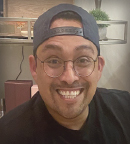In the summer of 2012, I was living my dream. At 28 years old, I had gone from an impoverished childhood in South Central Los Angeles to the high life in the city of Los Angeles. Unable to afford to go to college, an after-school program helped launch me into a career in the hospitality industry. I quickly rose from working at the front desk of a premier hotel to becoming its youngest Director of Revenue Management, putting me a step closer to my ultimate goal of becoming Vice President.
Along the way up the corporate ladder, I learned the invaluable lesson that the most important currency in life is not money—it’s knowledge—because knowledge never decreases in value. I would lean on that lesson over the next decade as I learned to live with cancer and its aftermath.

Carlos Rene Valdez
Getting a Cancer Diagnosis
Arguably, what I loved most after my career was dancing. I don’t drink, smoke, or take recreational drugs. I guess you could say that dancing was my drug of choice. One Friday night, as I was preparing to go out to a club to celebrate the start of the weekend, the subtle lower back pain I had been experiencing for months suddenly became unbearable. My mother had suffered from kidney stones, and I was certain the same condition was plaguing me now. But as the pain grew more intense, my partner insisted he take me to the emergency room at Cedars-Sinai Medical Center.
After 3 days of a battery of tests, the results showed the source of my back pain was not kidney stones, but a large tumor about the size of a grapefruit, pressing on my organs in the right side of my abdomen. A biopsy of the mass determined I had advanced-stage Burkitt lymphoma.
My oncologist recommended 13 rounds of intensive chemotherapy with the goal of curing the cancer. I decided to take a 3-month medical leave of absence from my job while undergoing the treatment and recovery. My convalescence was difficult, but I consoled myself with the fact that soon I would put cancer behind me and continue on my career path.
Receiving a Financial Lifeline
Although the treatment was initially successful in getting me into a remission, the cancer recurred just 3 months later. The news was devastating, but I never thought or uttered the words, “why me?” My attitude was, what do I need to do next to get back to focusing on my life goals?
My oncologist scheduled another eight rounds of chemotherapy in preparation for an autologous stem cell transplant. Unfortunately, in addition to worrying about surviving cancer, I now had to worry about how to pay for the treatment.
During my medical leave, my employer changed our health insurance company, and I was denied coverage for the transplant by the new insurance company because I had a preexisting condition. I knew my life depended on the transplant. I also knew I could not afford to pay for the life-saving treatment.
To my complete surprise and gratitude, Cedars-Sinai Medical Center offered to cover my medical expenses through its financial assistance program. It took a lawsuit and many months of wrangling, but I was finally able to get the insurance company to pay for the cost of my care and reimburse the medical center. I was determined to make sure the money would be there for the next patient with cancer in financial need.
Soon, Cedars-Sinai would offer me another lifeline.
Coping With the Long-Term Debilitating Effects of Cancer
The stem cell transplant was not only physically and financially debilitating, but it was emotionally crushing as well. Although the transplant has given me a durable remission for more than a decade, I’m still coping with the lingering side effects of the aggressive treatment, including cognitive issues, clinical depression and anxiety, and chronic fatigue.
Following treatment, I had assumed I would be the same person I was before my cancer diagnosis and could resume my high-powered career, but I was wrong. The combination of ongoing side effects makes it impossible for me to return to the work I had before cancer.
With bills mounting and no steady income, I became homeless and sank into an ever-deeper depression and attempted suicide. I knew I could not continue down this path of hopelessness and despair and decided to enroll in the Cancer Rehabilitation & Survivorship Program at the Samuel Oschin Comprehensive Cancer Institute at Cedars-Sinai Medical Center. The program is run by Arash Asher, MD, whom I credit with saving my life.
The program has given me the emotional and mental health support I need. Today, my depression and anxiety are under control, and I’m working toward building a new future. I’ve launched a tote bag company with the goal of one day reestablishing my financial independence and helping fund mental health programs for at-risk young cancer survivors.
Thriving After Cancer
Although I’m thankful for all the progress in cancer care that has enabled increases in survival rates for patients with cancer, I feel more needs to be done to help survivors understand they may have to adjust to a new normal way of life after cancer.
If there is one silver lining in hitting rock bottom after a cancer diagnosis, it is that you lose your fear of pursuing a goal and a life you never would have dreamt of pursuing. For that, I am grateful.
Mr. Valdez lives in Los Angeles.
Editor’s Note: Columns in the Patient’s Corner are based solely on information The ASCO Post received from patients and should be considered anecdotal.

